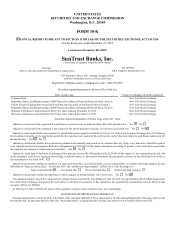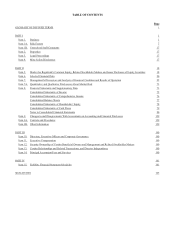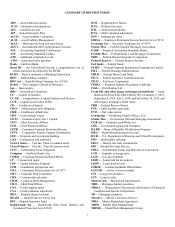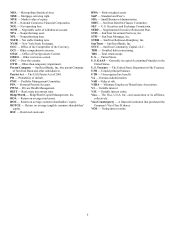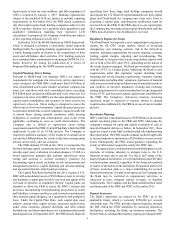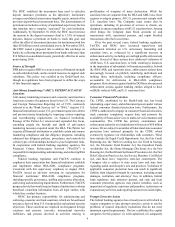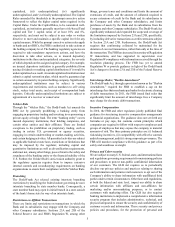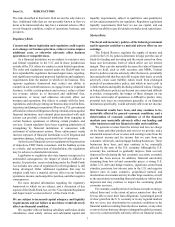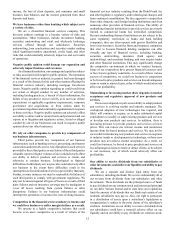SunTrust 2015 Annual Report Download - page 30
Download and view the complete annual report
Please find page 30 of the 2015 SunTrust annual report below. You can navigate through the pages in the report by either clicking on the pages listed below, or by using the keyword search tool below to find specific information within the annual report.2
capital requirements and significant changes in the regulation of
OTC derivatives, reforms the regulation of credit rating agencies,
increases controls and transparency in corporate governance and
executive compensation practices, incorporates the Volcker
Rule, requires registration of advisers to certain private funds,
and affects significant changes in the securitization market.
Dodd-Frank Act requirements typically apply to BHCs with
greater than $10 billion of consolidated assets, and the
requirements increase at certain asset size thresholds (most
notably, $50 billion of consolidated assets and $250 billion of
consolidated assets).
Enhanced Prudential Standards
BHCs with consolidated assets of $50 billion or more are subject
to enhanced prudential standards and capital requirements. The
Dodd-Frank Act directs the FRB to establish heightened
prudential standards for: (i) risk-based capital requirements and
leverage limits, (ii) liquidity risk management requirements, (iii)
overall risk management requirements, (iv) stress tests, (v)
resolution planning, (vi) credit exposure and concentration
limits, and (vii) early remediation actions that must be taken
under certain conditions in the early stages of financial distress.
In February 2014, the FRB adopted a final rule
implementing the liquidity and risk management requirements
as enhanced prudential standards, imposing requirements for
greater supervision and oversight of liquidity and general risk
management by boards of directors and incorporating capital
planning and stress testing requirements. In addition, the rule
requires publicly traded U.S. BHCs with total consolidated assets
of $10 billion or more to establish enterprise-wide risk
committees. The liquidity risk management requirements are in
addition to those imposed by the LCR rule. The FRB has yet to
adopt rules regarding single counterparty exposure limits and
early remediation.
Enhanced Capital Standards
In July 2013, the U.S. banking regulators promulgated final rules
substantially implementing the Basel III capital framework and
various Dodd-Frank Act provisions (the “Capital Rules”). The
Capital Rules increased regulatory capital requirements of U.S.
banking organizations in a manner that more closely reflected
risk exposures, and brought the regulatory capital framework
into compliance with Basel III. The Capital Rules revise the level
at which the Bank becomes subject to corrective action as
described in the “prompt corrective action” section below.
Furthermore, in association with the “Collins” amendment to the
Dodd-Frank Act, the federal banking regulators must impose a
generally applicable leverage capital ratio regardless of
institution size. The Collins Amendment also phased out certain
“hybrid” capital elements from Tier 1 capital treatment. The
Company became subject to the Capital Rules on January 1,
2015. Certain Capital Rule requirements will commence or be
phased in over several years.
The Capital Rules introduce a new capital measure, CET1,
which (i) specifies that Tier 1 capital consists of CET1 and
additional Tier 1 capital instruments satisfying particular
requirements, (ii) requires that most adjustments to regulatory
capital measurements be made to CET1 rather than to the other
capital components, and (iii) changes the scope of adjustments.
The Capital Rules require:
• a minimum CET1 capital ratio of 4.5%
• a Tier 1 capital ratio, with a numerator consisting of the sum
of CET1 and “additional Tier 1 capital” instruments meeting
specified requirements, of 6.0%
• a total capital ratio, with a numerator consisting of the sum
of Tier 1 capital (CET1 and additional Tier 1 capital ) and
Tier 2 capital, of 8.0%
• a 2.5% “capital conservation buffer,” phased-in starting
January 1, 2016, which is added to the CET1, Tier 1, and
Total capital ratios, effectively increasing CET1, Tier 1, and
Total capital to 7.0%, 8.5%, and 10.5%, respectively by 2019
• a minimum Tier 1 leverage ratio of 4.0%
The Capital Rules further provide for a significant increase to
capital charges for certain commercial real estate loans
determined to be “high volatility real estate exposures” that
would apply, subject to certain exceptions, to a large array of
commercial real estate loans, including small business loans, and
owner-occupied business properties. The Capital Rules also
require certain institutions to include unrealized gains and losses
on securities AFS, accumulated gains and losses on cash flow
hedges, and AOCI related to defined benefit plans in the
calculation of CET1. An exception is provided for banks with
consolidated assets of less than $250 billion that make a one-
time election to exclude AOCI from the capital ratio calculations.
The Company has made this election.
CET1, additional Tier 1 and Tier 2 capital are each
respectively defined by various specific criteria. For most
banking organizations the only security that qualifies as CET1
is voting common stock, or its close equivalent. The most broadly
issued security qualifying as additional Tier 1 capital is
noncumulative perpetual preferred stock, or its close equivalent.
Tier 2 capital may include other securities issued by banking
organizations such as subordinated debt, cumulative preferred
stock, or term preferred stock. In limited circumstances, and
subject to various restrictions, certain minority interests in bank
subsidiaries and other operating subsidiaries may be included as
Tier 1 or Tier 2 capital.
The capital conservation buffer is a buffer above the
minimum levels designed to ensure that banks remain well-
capitalized even in adverse economic scenarios. Restrictions on
capital distributions, share repurchases and redemptions, and
discretionary bonus payments to executive officers are imposed
on banks that are unable to sustain this buffer above the minimum
CET1, Tier 1, and Total capital ratios.
See additional discussion of Basel III in the "Capital
Resources" section of Item 7, MD&A, in this Form 10-K.
Mandatory Liquidity Coverage Ratio (“LCR”); Net Stable
Funding Ratio (“NSFR”)
In September 2014, the FRB, OCC, and the FDIC approved
rulemaking that established, for the first time, a quantitative
minimum LCR for large, internationally active banking
organizations, and a less stringent LCR (“modified LCR”) for
BHCs with less than $250 billion in total assets, such as the
Company. The LCR requires a banking entity to maintain
sufficient liquidity to withstand an acute 30-day liquidity stress
scenario. The LCR became effective for the Company on January
1, 2016, with a minimum requirement of 90% of high-quality,







